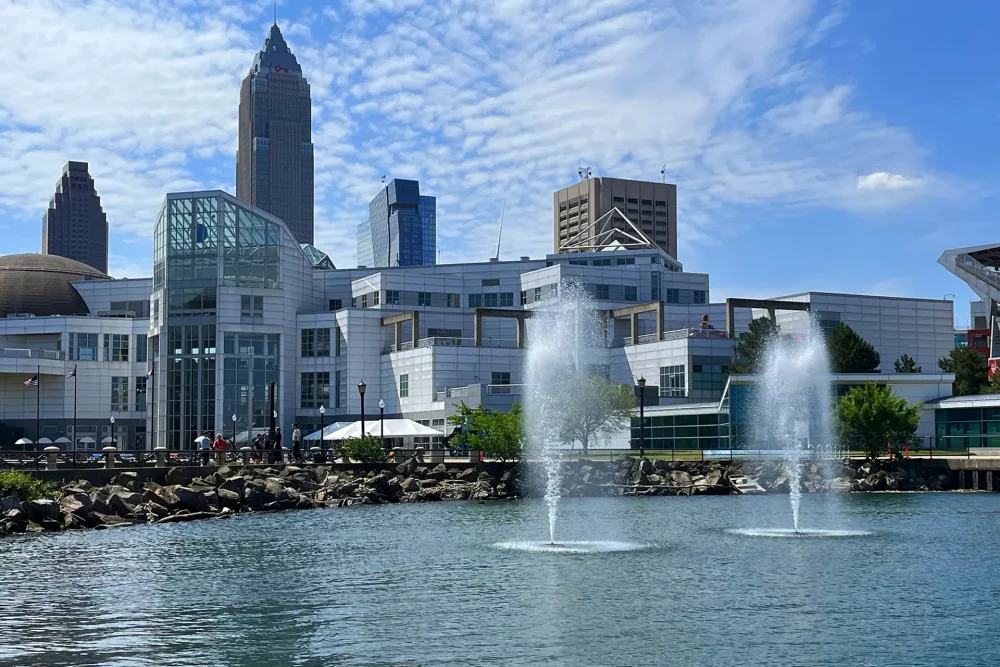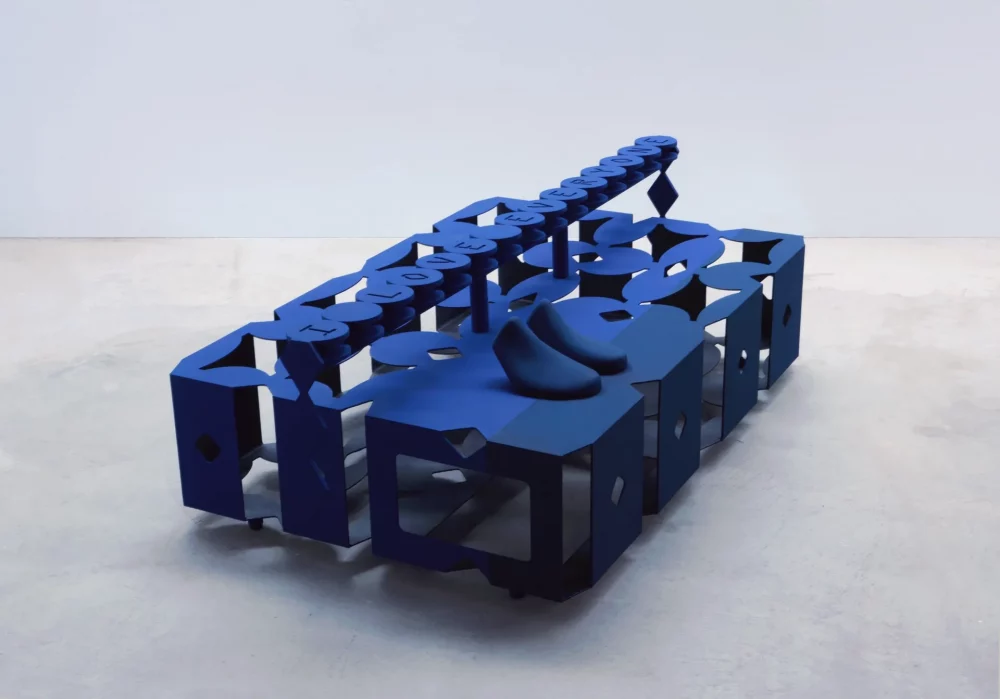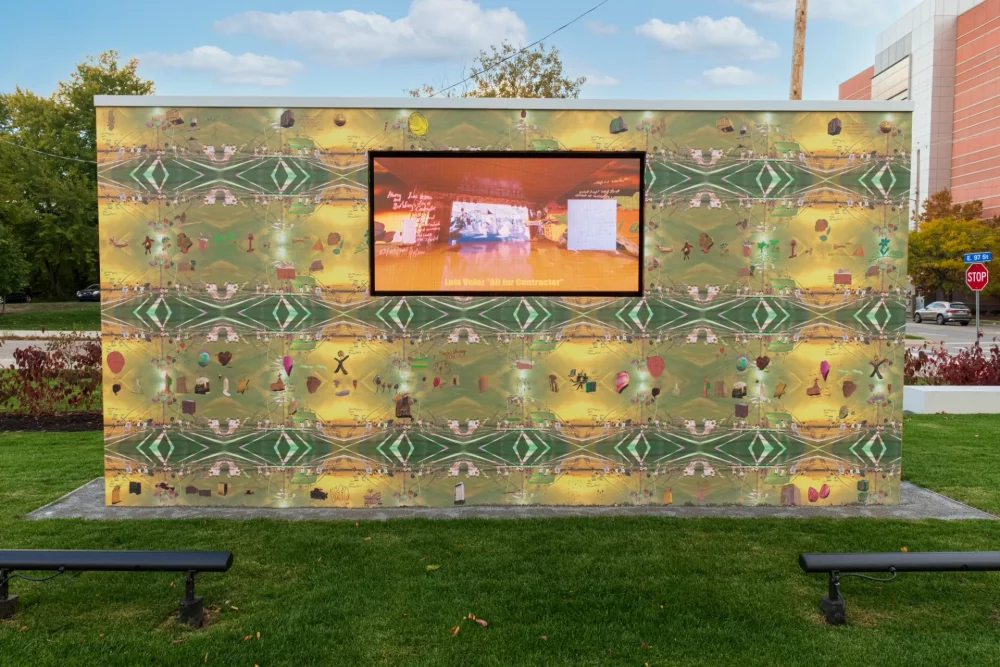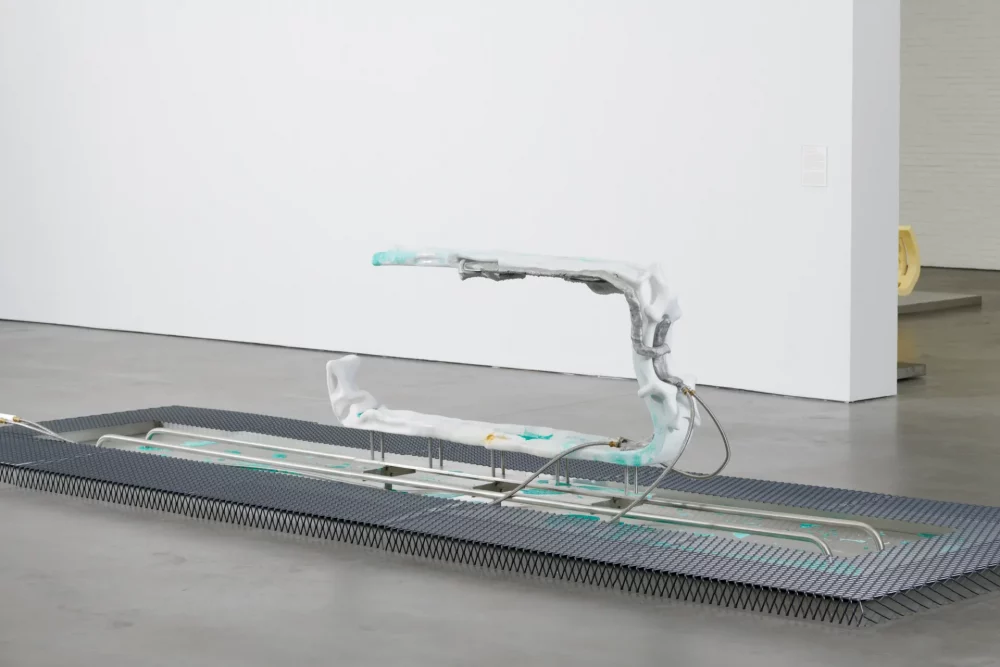
- Source: The Art Newspaper
- Author: Claire Voon
- Date: July 21, 2022
- Format: Online
Cleveland’s Front International triennial explores healing through art-making
The second edition of the exhibition brings together the work of 100 artists across Ohio

Cooking Sections, To Those Who Nourish (2022). Commissioned by FRONT International: Cleveland Triennial for Contemporary Art with support from The Andy Warhol Foundation for the Visual Arts and in partnership with North Coast Harbor, Downtown Cleveland Alliance, Great Lakes Science Center, and the US Army Corps of Engineers. Courtesy and © Cooking Sections.
Across the harbour from Cleveland’s Rock & Roll Hall of Fame, where yachts can be spotted gliding out to Lake Erie, two water spouts shoot skyward like whale exhalations. This fountain is part of To Those Who Nourish (2022), a three-year project by London-based duo Cooking Sections that addresses low oxygen levels in the lake caused by agricultural runoff. Organised by Spaces gallery and commissioned by the Front International: Cleveland Triennial for Contemporary Art, whose second edition opened 16 July after a one-year pandemic delay, the work is a tribute to nine Ohio farms committed to eliminating chemical fertiliser.
“The fountain’s main purpose is to celebrate the farmers that are invested with their work to save Lake Erie, in a city and region that many times commemorates those who have benefited the most from extractive practices,” Cooking Sections’ Alon Schwabe and Daniel Fernández Pascual say, adding that the pumping aerates the water but is no panacea: “The problem needs to be addressed at the source and not through any technological or geoengineering ‘solutions’.”
As a small but highly visible gesture to improve the lake’s health, the fountain is among the most palpable representations of the triennial’s 2022 theme of healing. Titled Oh, Gods of Dust and Rainbows, after a line in a Langston Hughes poem, the exhibition asks “the question of how can art heal and transform at different scales”, Prem Krishnamurthy, Front’s artistic director, says. “We looked in Cleveland and saw a history of healing and a history of community.”
Especially apt for a year unsettled by crises including new Covid variants, unprecedented heatwaves and mounting gun violence, the theme emerged pre-pandemic, in 2019. “We spent time here thinking about the immense prosperity produced in Cleveland in a particular moment, but also the environmental and social costs of that, the fact that Cleveland does experience racial injustice and division,” Krishnamurthy says. “Just in the last few weeks, with the shooting of Jayland Walker in Akron, we can see how this region is still experiencing so much division and suffering. But while we were looking into these historical facts, we also found reasons for hope.”
The result spreads 100 artists across Cleveland, Akron and Oberlin, including in spaces like gardens, bars and the Cleveland Clinic, Ohio’s second-largest employer after Walmart. Many are from Cleveland or the surrounding region, including Renée Green, whose first major exhibition in her hometown, the must-see Contact (2022), fills the Museum of Contemporary Art Cleveland with a poetic mesh of ideas that draws her works into affecting conversation with former students and other artists who have influenced her.
Front’s intended beginning is Transformer Station, which provides examples of how a routine of art-making can heal, the pleasures of gathering around art and the grand shifts artists can ignite. There are works by several artists who resurface throughout the triennial, such as Paul O’Keeffe, whose large-scale sculptures embody the unending grief of losing a child, and Dexter Davis, who has for years processed the trauma of a near-fatal shooting through collage-based works. Their recurrences help create cohesion in what often feels like an ambiguous (though sometimes rightfully opaque) approach to healing, with didactics infrequently naming what exactly has provoked the need to heal.

Paul O’Keeffe, In Memoriam (I Love Everyone) (2021–22). Courtesy and © Paul O’Keeffe.
One work explicit of the pain that informs it is February, one of Devan Shimoyama’s suspended hoodies adorned with silk flowers and rhinestones—glittering shrines to Black men killed by police that avoid reproducing traumatic imagery. It’s the first work visitors encounter in a group show at the Akron Art Museum, where it invokes the fatal police shooting of Jayland Walker on 27 June. The curators do not present any statements about police brutality in Akron, although they have quietly postponed the installation of a public dance floor by Swedish group Dansbana!.
The Akron Art Museum presentation is one of the triennial’s strongest, gathering intergenerational artists on craft and healing. Judith Scott’s mesmeric bound sculptures and Chakaia Booker’s lyrically kinetic, manipulated tires are here with emerging artists like Akron-based Seuil Chung, whose brightly glazed stoneware frame the body as a site of play and radiate an endearing cartoonish quality. Nearby, Dominic Palarchio’s small-scale readymades fixate on our everyday proximity to environmental hazards, fusing safeguards like water purifiers and carbon monoxide alarms with grimy filters and gas cylinder caps.
Northwestward in Oberlin, Ahmet Öğüt’s installation at the Allen Memorial Art Museum also reminds that safety is a precarious state. The work Bakunin’s Barricade (2022) follows the anarchist Mikhail Bakunin’s unrealised proposal during Dresden’s 1849 socialist uprisings to adorn barricades with paintings from the National Museum to deter Prussian troops. Half of Öğüt’s work is a towering barricade integrating works in the Allen’s collection by artists including Andy Warhol and Eva Hesse, selected with Oberlin students’ input. The other half is a contract requiring the museum to loan out the barricade if requested during an uprising. Öğüt expands art’s possibilities in a time of upheaval while urging the value of opposition. “I saw barricades during the uprisings in Istanbul, I witnessed Occupy Wall Street, and in Ukraine, they took a tank from the museum back to the streets,” he says. “This is actually happening. It’s not fantasy.”
Öğüt’s work is one of several in Front that engages with neighbouring communities, a curatorial decision that likely responds to criticism that the inaugural triennial failed to represent locals. In addition to their fountain, Cooking Sections is in long-term discussions with farmers about alternative farming methods and related challenges, such as legislation, credit structures and access to land. The forum aims to build a support network, encourage knowledge-sharing and “increase the visibility and viability of this type of work that mostly goes unseen in states like Ohio, which are predominantly run by big ag and agricultural corporations,” the artists say.

Jacolby Satterwhite, Dawn (2021). Commissioned by Cleveland Clinic in collaboration with Front International: Cleveland Triennial for Contemporary Art and with community support from Karamu House. Courtesy of the artist and Mitchell-Innes & Nash, New York. © Jacolby Satterwhite.
Then there’s Dawn (2022) by Jacolby Satterwhite, who partnered with Clevelanders LaToya Kent and RA Washington to ask residents of the Fairfax neighbourhood to imagine utopia. Answers came as drawings (participants were paid), which Satterwhite animated and integrated in an immersive, playable arcade at the Cleveland Institute of Art (CIA) and a permanent outdoor video on Cleveland Clinic’s campus. The clinic has a historically fractured relationship with surrounding Black neighbourhoods, and Dawn was a way for it to “interface with the community in a different way,” Krishnamurthy says.
One gorgeous, trance-inducing video by Satterwhite loops the refrain “This is healing music”, which could describe several other works. Cory Arcangel’s Hail Mary is an algorithmic score for carillon generated daily and played at noon by carillonist George Leggiero from the tower of a Cleveland church. Merging traditional bell music and new media, the performance is magically madcap, injecting brief wonder into the routine of time.
Meanwhile, at Cleveland Public Library’s main building, Jace Clayton presents 40 Part Part (2022), a riff on Janet Cardiff and George Bures Miller’s The Forty Part Motet (2001), which deconstructs a 16th-century choral work across 40 speakers in a circle. Clayton updates this for the Bluetooth era, inviting visitors to connect their devices and play tunes that an algorithm mutates and defamiliarizes. The results, which have a strong textural quality, call those present in the typically hushed environment to bask in the pure joy of amusingly fickle beats.
At Cleveland Clinic’s Samson Pavilion, karaoke lovers can gather in the KTV-lounge-like setting for Wong Kit Yi’s Inner Voice Transplant, a video that meditates on illness and spiritual healing over centuries of diverse health practices. As Wong’s narrator speaks, her words appear like inviting karaoke lyrics. At one point, she expresses skepticism over healing—one of the few moments in the triennial that refreshingly question the efficacy of, and access to, this process.

Isabelle Andriessen, Necrotic Core (detail) (2021). Photo: Aurélien Mole. Courtesy and © the artist.
“Not everybody can be healed and maybe not everyone needs to be healed,” Wong’s narrator says. “Sometimes I feel like the word ‘healing’ is beginning to sound like a generic over-the-counter medication that can be thrown at any problem. And perhaps it can cause additional problems. It can make us get caught up in yearning for an idealised norm that never actually existed.”
Futuristic sculptures by Isabelle Andriessen at Spaces embody these complications. Constructed of ceramics, steel, wax, silicone and plastics, they ooze a toxic aura. Nocturnals (2021), which resembles some cyborg critter, trails wires that cool its insides so it sweats brown liquid. In an abject performance, this pool gradually expands, suggesting decay. Andriessen’s sculptures reject traditional modes of care, accepting collapse as inevitable. In the context of this triennial, they question just how far healing can get us, especially in a gritty, poisoned world. They confront us with the ugly truth that not every wound can be mended.
Front International: Cleveland Triennial for Contemporary Art, until 2 October, various locations across Ohio

